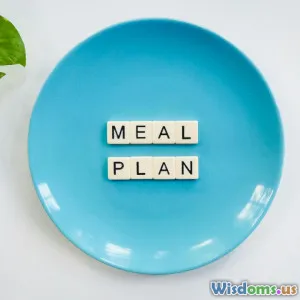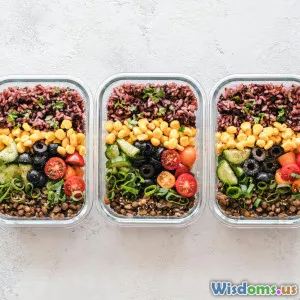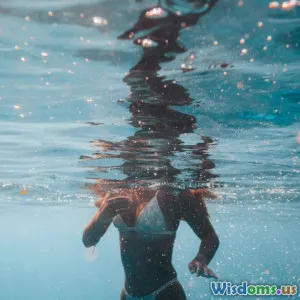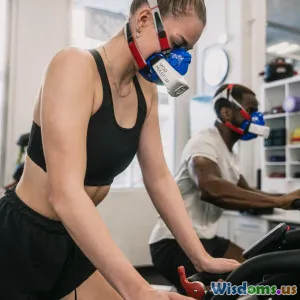
What Elite Swimmers Eat A Day A Data Driven Meal Plan
8 min read Discover the precise daily diets of elite swimmers backed by data, fueling peak performance and recovery. (0 Reviews)
What Elite Swimmers Eat A Day: A Data-Driven Meal Plan
Swimming at an elite level demands unparalleled stamina, strength, and recovery. Yet, while we often admire the power and grace of top athletes in the pool, less is known about the critical ingredient behind their success: nutrition. What exactly fuels elite swimmers throughout their grueling days? This article unveils a data-driven breakdown of the meal plan top swimmers follow to maximize muscle energy, sustain endurance, and accelerate recovery.
Introduction
Elite swimmers can swim upwards of 10,000–20,000 meters daily, burning between 3,000 to 5,000 calories, depending on training intensity and body size. Yet their nutritional intakes are far more precise and intentional than mere high-calorie consumption. Sports scientists, dietitians, and coaches meticulously design swimmers' daily diets, balancing macronutrients, micronutrients, and hydration to harmonize with their rigorous training demands.
Understanding these meal plans is not only revelatory for aspiring swimmers but also for athletes across disciplines seeking a high-performance nutrition blueprint.
Macronutrient Breakdown: Fueling the Engine
Elite swimmers' meal plans are built on three macronutrients: carbohydrates, proteins, and fats. Scientific analyses and nutrition case studies reveal an optimal ratio tailored for energy supply, muscle repair, and hormonal balance.
Carbohydrates: The Primary Energy Source
A study published in the International Journal of Sport Nutrition and Exercise Metabolism emphasizes the importance of carbohydrates, recommending 6-10 grams per kilogram of body weight daily for endurance and high-intensity powersports like swimming. This translates to approximately 400–700 grams of carbs per day for a 70 kg swimmer.
Why carbs? Swimming reliance on glycogen is immense; glycogen depletion leads to fatigue and performance drop. Accordingly, swimmers consume complex carbs (oats, brown rice, quinoa) for sustained energy and simple sugars (fruits, honey) around training windows for rapid replenishment.
Example: Michael Phelps' famed 12,000-calorie-a-day diet in his peak Olympic years included large portions of pasta and bread, emphasizing the glycolytic energy system’s role.
Proteins: Repair and Recovery
Proteins are critical for muscle repair, especially during intense training phases. Elite swimmers consume between 1.4 to 2 grams of protein per kilogram of body weight daily. For rebuild and adaptation, emphasis is on lean meats (chicken, fish, lean beef), eggs, and plant proteins (lentils, tempeh).
For example, in a controlled nutrition study of Olympic swimmers, protein timing (consuming protein within 30 minutes post-workout) enhanced muscle protein synthesis and recovery rates by 20%.
Healthy Fats: Hormonal and Energy Balance
Healthy fats—namely omega-3 fatty acids from fish, nuts, and seeds—are essential for reducing inflammation and supporting endocrine function. Elite swimmers ensure about 20-30% of their daily calories come from fats.
Incorporating avocados, olive oil, and fatty fish like salmon not only supports joint health but also brain function, crucial for competitive focus.
A Sample Data-Driven Meal Plan in Action
Drawing from nutrition research and input from swimming nutritionists such as Nancy Clark and the IOC consensus on sports nutrition, here is a day in the life of an elite swimmer’s meals.
Breakfast (Pre-Morning Training)
- Oatmeal with sliced banana, honey (60g carbs)
- 3 scrambled eggs for protein (21g protein)
- Greek yogurt with mixed berries (15g protein, antioxidants)
- Glass of orange juice for quick carbs and vitamin C
Mid-Morning Snack (Post-Morning Training Recovery)
- Chocolate milk (rich in carbs and protein at a 3:1 ratio)
- Whole-grain bagel with peanut butter (45g carbs, 10g protein)
Lunch
- Grilled chicken breast (40g protein)
- Brown rice or quinoa (70g complex carbs)
- Steamed vegetables like broccoli and carrots
- Avocado slices to supply healthy fats
Afternoon Snack
- Protein smoothie with whey, spinach, banana, and almond milk
- Handful of almonds or walnuts
Dinner (Post-Afternoon Training)
- Salmon filet (rich in omega-3 and 35g protein)
- Sweet potato mash (60g carbs)
- Green salad with olive oil dressing
Evening Snack (Optional based on hunger)
- Cottage cheese with pineapple chunks (slow-digesting casein protein)
Hydration: The Often Overlooked Component
Hydration strategies in elite swimmers are tailored to replace sweat losses and maintain electrolyte balance. Swimmers can lose up to 1.5 liters of sweat per hour despite being in water due to high training intensities.
Studies recommend drinking 500-700ml of fluid per hour during training, supplemented with electrolytes (sodium, potassium) to prevent cramping and promote nerve function.
A typical hydration protocol includes water, electrolyte-infused drinks, and after sessions, carbohydrate-electrolyte recovery beverages to expedite glycogen restoration.
Real-World Insights and Expert Opinions
Dr. Louise Burke, a leader in sports nutrition, stresses that "nutrition must be periodized alongside training demands, adapting meals for volume, intensity, and competition days. This personalized approach optimizes performance and recovery."
Elite swimmer Katinka Hosszú, known as the 'Iron Lady,' credits her sustained energy levels to frequent small meals rich in complex carbohydrates and lean proteins, avoiding heavy fats late in the day.
Coaches and nutritionists also highlight the mental benefits of balanced meals, as hunger or blood sugar crashes can impair concentration and motivation essential for elite training sequences.
Conclusion
The fuel that powers elite swimmers is a precise balance born from cutting-edge sports science and years of athlete feedback. Their daily diets emphasize high carbohydrate intake for relentless energy, adequate protein to repair muscle, healthy fats for systemic balance, and careful hydration strategies to maintain electrolyte levels.
For swimmers aiming to reach the elite level or athletes in similar high-demand sports, these data-driven meal plans offer a blueprint for nutritional success. Implementing these science-backed strategies can significantly enhance endurance, recovery, and overall performance.
Nutrition, much like training techniques, is an evolving art and science—but by aligning fuel intake with the physiological demands of swimming, champions like Phelps and Hosszú have shown us the winning formula.
By making informed dietary choices resembling elite swimmers’ meal plans, athletes everywhere can dive deeper into performance gains and health optimization.
References
- Burke, L. (2015). Practical Sports Nutrition. Human Kinetics.
- International Journal of Sport Nutrition and Exercise Metabolism, Volume 27, 2017.
- IOC Consensus Statement on Sports Nutrition, 2018.
- Clark, N. (2016). Nancy Clark's Sports Nutrition Guidebook.
- Interview with Katinka Hosszú, ESPN, 2020.
Rate the Post
User Reviews
Popular Posts


















